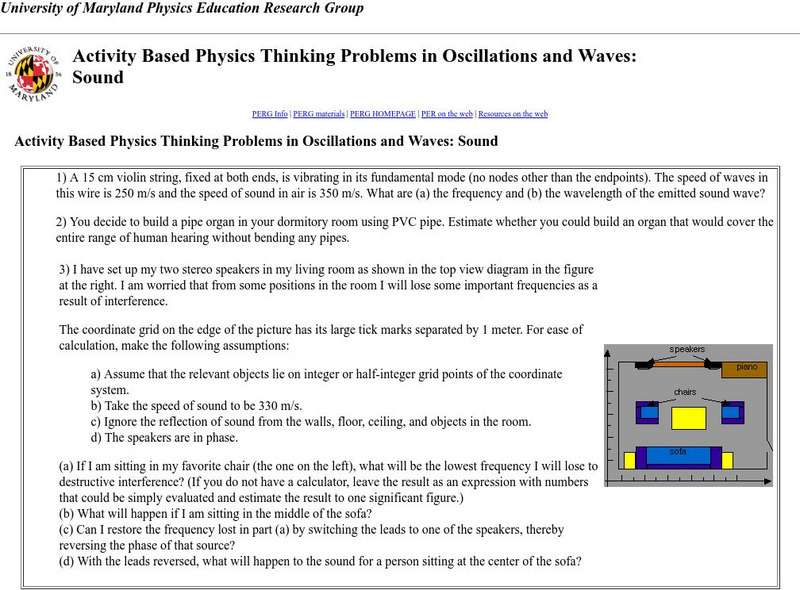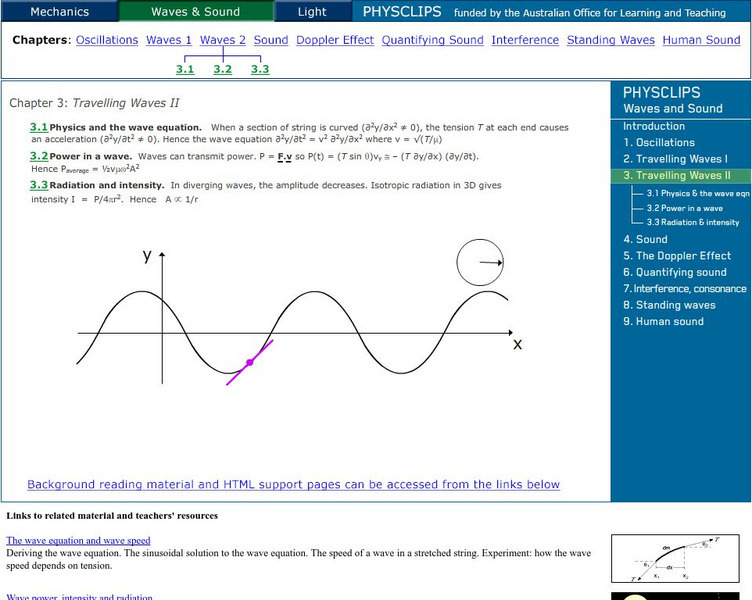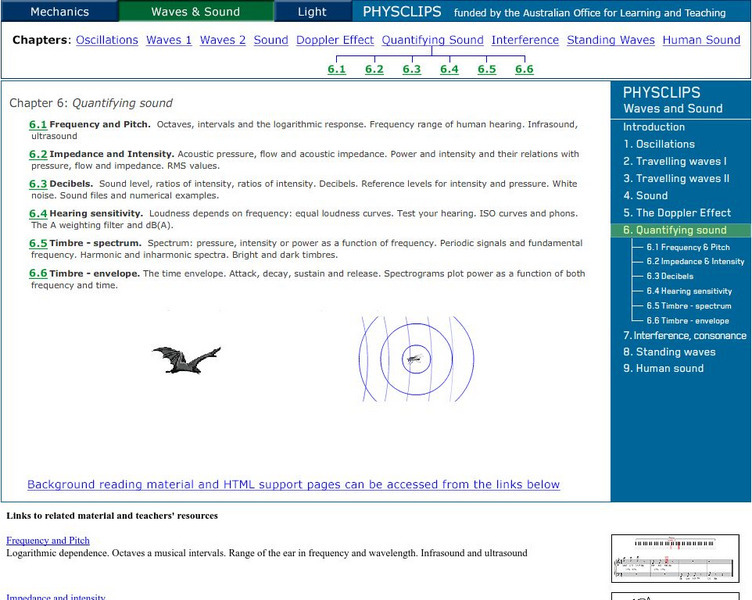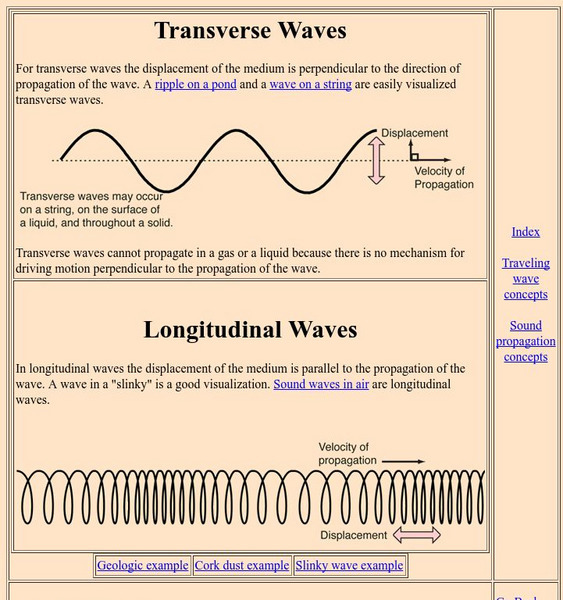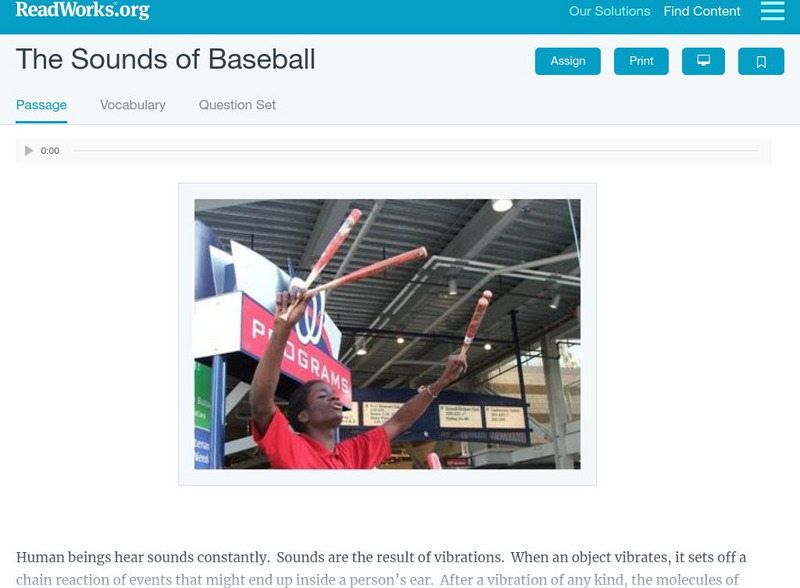University of Maryland
University of Maryland: Thinking Problems With Sound
A series of thought-provoking multiple-choice questions from the University of Maryland on the topic of sound and acoustics. One question pertains to the acoustics of a furnished room with two speakers; demands a basic understanding of...
Physics Hypertextbook
The Physics Hypertextbook: The Nature of Sound
Study the details of sound from characteristics to speed, ultrasound, infrasound, and other aspects of sound waves.
University of New South Wales (Australia)
University of New South Wales: School of Physics: Physclips:travelling Waves Ii
Physiclips thoroughly investigates traveling wave with animations and film clips. Understand the wave equation, power in a wave, and radiation and intensity.
University of New South Wales (Australia)
University of New South Wales: School of Physics: Physclips: Travelling Waves I
A learning module exploring travelling waves. Learn about reflections, wave travelling equations, waves on a string, and travelling sine waves with animations and videos.
University of New South Wales (Australia)
University of New South Wales: School of Physics: Physclips: Oscillations
Physiclips thoroughly presents wave and sound concepts about oscillations with animations and film clips.
CK-12 Foundation
Ck 12: Wave Speed Calculations
[Free Registration/Login may be required to access all resource tools.] Students investigate and analyze characteristics of waves, including velocity, and calculate the relationship between wave speed, frequency, and wavelength.
University of New South Wales (Australia)
University of New South Wales: School of Physics: Physclips: Quantifying Sound
Learn about terms to quantify sound like pitch, frequency, decibels, and much more in this learning module. Learning module includes animations and videos.
Georgia State University
Georgia State University: Hyper Physics: Speed of Sound
Physics tutorial on measuring the speed of sound in dry air. An interactive form allows the student to practice solving problems involving the temperature dependence of the speed of sound.
Physics Classroom
The Physics Classroom: Sound Properties and Their Perception
The concept of pitch and frequency is covered in this tutorial. Learn what frequency and pitch are, the difference between infra sound and ultrasonic frequencies, and how pitch is related to the frequency of a sound.
Physics Classroom
The Physics Classroom: Boundary Behavior
Educational tutorial features a physics tutorial on the behavior of sound waves specifically focusing upon boundary behavior. Be sure to view the attached animations for further understanding.
Physics Classroom
The Physics Classroom: Standing Wave Patterns
Educational tutorial highlights standing wave patterns. Discover more about them and be sure to click on the animations for additional study.
Georgia State University
Georgia State University: Hyper Physics: Water Tube Resonance Experiment
Online physics lab experiment in which students use resonating waves inside of a closed-end air column to determine the speed of sound. The form allows students to check their answers and receive immediate feedback.
Georgia State University
Georgia State University: Hyper Physics: Transverse and Longitudinal Waves
The physics tutorial illustrates and explains the distinction between transverse and longitudinal waves. Related links provided.
CK-12 Foundation
Ck 12: Physics: Waves Study Guide
[Free Registration/Login may be required to access all resource tools.] This guide gives a detailed overview of mechanical waves and the characteristics of waves. Covers wave behavior, including types of interference, resonance, and the...
Georgia State University
Georgia State University: Hyper Physics: Wave Motion
Two wave graphs depicting a sine wave and relating the various characteristics (wavelength, amplitude, frequency, and period) of a wave to each other. The site includes an interactive JavaScript form in which the visitor enters one...
Khan Academy
Khan Academy: Transverse and Longitudinal Waves Review
Overview of key terms and skills for waves, including how to identify longitudinal and transverse waves.
Georgia State University
Georgia State University: Hyper Physics: The Place Theory
An indexing page for an elaborate and in-depth hyper-textbook on various physics topics. This page indexes several others which pertain to human ability to perceive sound and recognize pitch. Introduces and explains Place Theory.
CK-12 Foundation
Ck 12: Physical Science: Intensity and Loudness of Sound
[Free Registration/Login may be required to access all resource tools.] Discusses the intensity of sound and how it relates to loudness, the decibel levels of different sounds, and factors that affect sound intensity.
CK-12 Foundation
Ck 12: Physical Science: Wavelength
[Free Registration/Login may be required to access all resource tools.] What wavelength is and how it relates to the energy of a wave.
Georgia State University
Georgia State University: Hyper Physics: Interference of Sound
Information about the interference of sound and its causes. Well-illustrated and good explanations of the concepts; part of a large hyper-textbook on various physics concepts.
University of Toronto (Canada)
University of Toronto: Flash Animations for Physics
This site boasts an extensive list of physics animations that cover topics such as electricity, magnetism, quantum mechanics, and relativity. Variables can be manipulated for each demonstration.
OpenStax
Open Stax: Catherine Schmidt Jones: Sound and Music
Introduce some activities that introduce students to the physics of sound. They will also learn how various instruments produce sound. Included are downloadable pdf worksheets and answer sheets to use.
Read Works
Read Works: The Sounds of Baseball
[Free Registration/Login Required] An descriptive text about the sounds a person would hear at a baseball game. A question sheet is available to help students build skills in reading comprehension.
Physics Classroom
The Physics Classroom: Sound Waves and Music: Guitar Strings
A guitar string has a number of frequencies at which it will naturally vibrate. These natural frequencies are known as the harmonics of the guitar string. Students work through several example problems.


